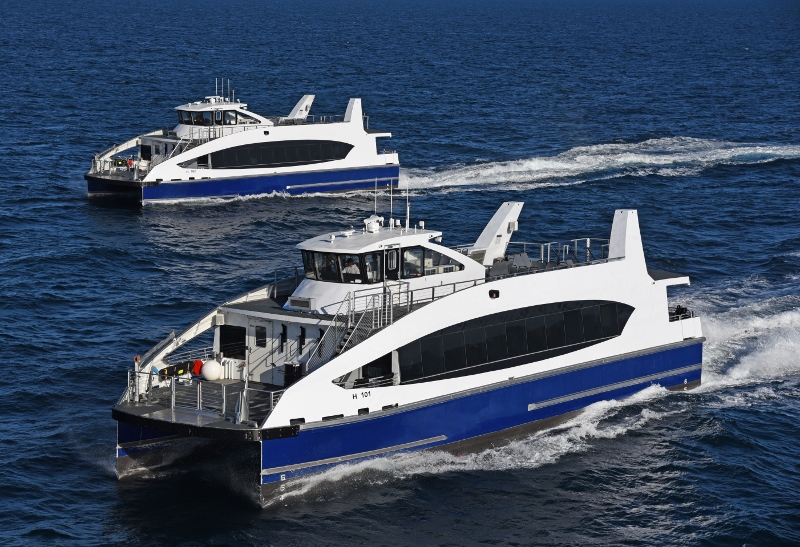NYC Ferry captains are preparing for the arrival of three more new vessels by training on bridge deck simulators at the State University of New York Maritime College.
“Our boats are being delivered right now, and we have a May 1 start date,” said Richard Paine, regional director of health, safety, security, quality of service and environmental protection (HSSQE) for NYC Ferry Operated by Hornblower, the Hornblower subsidiary operating the new, city-subsidized public system.
With the first hires, new captains are split between making the nearly 2,000-mile new boat transits, and simulator training that began last week. Thirty captains are expected to be hired by the end of summer 2017.
The simulators use software developed by Transas America Inc., Bothell, Wash., to generate a virtual reality, 360-degree environment from the routes that ferry captains will be working. The software simulates the look and feel of operating the 86’x29’ Incat Crowther-designed, 149-passenger aluminum catamaran ferries, a fleet still under construction by Horizon Shipbuilding Inc. at Bayou La Batre, Ala., and by Metal Shark at its Franklin, La., yard.

Students at SUNY Maritime College train on the NYC Ferry bridge deck simulator at the college’s Throggs Neck campus. SUNY Maritime photo.
“We wanted to use SUNY as our training homeport and be able to use it throughout New York City,” said Paine, a SUNY Maritime graduate himself. Transas provides a range of maritime simulator software, including packages for other transit agencies, and the knowledge and capability to program in small but critical New York-centric details.
Those included the new ferry landing barges custom-built for the city Economic Development Corporation, the ferry project backer that will be installed at 22 landings around the city.
“That way we can actually practice docking,” Paine said. The programming also accounts for the tricky New York tides and currents, and the panoply of harbor traffic, from tugs and barges to recreational boats and cavorting Jetskis.
“The harbor is getting busier and busier every year,” Paine said. The software provides for setting levels of difficulty, from basic boat handling, to the moderate challenges of a typical workday, to bad weather and traffic scenarios that “throw everything” at the captain, Paine said.
Success on the simulator is a pass/fail, based on feedback from two instructors, one from NYC Ferry and the other from the SUNY Maritime faculty.
The Transas system is being used by SUNY students as well, and will work at other locations with educational and community partners, like the New York Harbor School, Paine said.
“Since we’re going to be in all these neighborhoods we want to be involved,” he said.
Annual refresher courses on the simulators will be part of the training regime for NYC Ferry operators. SUNY Maritime began positioning to become a regional center for simulator training with help from Bouchard Transportation Co., Melville, N.Y., which beginning in 2014 provided a grant and extensive technical aid for building a $750,000 state of the art simulator for tugboat, barge, and ATB training in the Fort Schuyler campus in Throggs Neck, N.Y.
The NYC Ferry simulator is a new tool for training crews of small commuter ferries, as most simulator training in the industry is oriented toward towing vessels, large vehicle ferries or ship assist tugboats.
As with the Bouchard simulator, the NYC Ferry simulator is set up to give trainees the feel for their vessel’s handling and response to control inputs. Hornblower personnel went to the Gulf coast for sea trials of the first new ferries, and “they feel that it’s pretty accurate” in the simulator setting.
“Simulator training allows our crew members to train in a controlled environment. It allows us to create scenarios that we may not see every day in New York Harbor,” said Dennis Robesch, a safety and training manager for NYC Ferry and another SUNY Maritime alumnus. “More importantly, it gives our captains the opportunity to train in the operation of the ferries prior to their delivery. Throughout my own career, simulator training has been an effective and priceless learning tool, and I feel like it will be the same for our new crew members as we gear up to launch May 1.”
The first of Metal Shark’s ferries, Hull 100 and Hull 101, departed Louisiana this week as did a second of the Horizon-built boats. Both Metal Shark-built ferries were running in tandem, making their way northward in the Atlantic after running the Gulf of Mexico coastline and rounding Key West, and expected to arrive in New York within the next few days.
"We produced these first two ferries from start to finish in less than nine months, which is a feat that was deemed impossible by many," said Metal Shark’s CEO Chris Allard. "However, we were confident in our team and our ability to make it happen."
"So much effort went into the construction of these boats. It's been an honor to build them and send them to New York, where they'll become a valuable part of the city's transit infrastructure for years to come," added Carl Wegener, Metal Shark's director of commercial sales.
New captains who started training on the simulators last week are preparing for the first routes to open between Rockaway in Queens and on the East River May 1. The system will expand in June and again in August, and build more in 2018. If successful the system will expand, and already neighborhood advocates on Staten Island are calling for service to the borough’s farther reaches, far away from the venerable Staten Island Ferry.




